Simple, 4-Ingredient Homemade Pizza Dough
This post may contain affiliate links. Please read my disclosure policy.
Up your pizza game with this simple, no-knead homemade pizza dough recipe. Made with 4 ingredients — flour, water, salt, and yeast — this dough is a snap to throw together, and you can use it the same day you mix it or store it in the fridge for up to 5 days (or freeze it!). If you love pizza with ballooned edges and crisp but pliable crusts, this is the pizza dough recipe you’ll come back to again and again. 🍕🍕🍕🍕🍕

Listen up: Don’t let anyone tell you you can’t make great pizza from start to finish in three hours. This is a simple 4-ingredient pizza dough recipe. The proportions are based on my mother’s peasant bread recipe, a high-hydration, no-knead, quick-to-stir together dough. It is the simplest of the simple homemade pizza recipes and, in my opinion, the tastiest, too.
Grab a bowl, a whisk, and a spatula — let’s get slinging 🍕🍕🍕🍕🍕
This post is organized as follows:
- Why High Hydration Pizza Dough is Best For a Home Oven
- Neapolitan Pizza Dough Recipe vs. Home-Oven Pizza Dough Recipe
- Pizza Dough Ingredients: Flour, Water, Salt, Yeast
- No-Knead Pizza Dough
- How to Handle High-Hydration Pizza Dough
- Two More Tips for Making the Best Pizza at Home
- Other Pizza-Making Equipment
- How to Make Pizza Dough, Step by Step
- Timing
- How to Freeze Pizza Dough
- 4 More Pizza Styles to Try
- FAQs + Troubleshooting
- My pizza cookbook: Pizza Night
Why High-Hydration Pizza Dough is Best For a Home Oven
The first step to making excellent pizza at home is to get comfortable working with high-hydration pizza doughs. High-hydration doughs, such as Jim Lahey’s popular no-knead dough, this simple sourdough pizza crust, or the one from my cookbook, Bread Toast Crumbs (which is the recipe below), are doughs made with a high proportion of water relative to the flour. The high proportion of water allows these types of doughs to be mixed together quickly and easily — no kneading or stand mixer required — and it also creates a pizza crust that stays crisp but moist during the cooking process with beautiful air pockets throughout.
Why? Let’s back up.
Neapolitan Pizza Dough Recipe vs. Home-Oven Pizza Dough Recipe
In your search for the perfect pizza dough recipe, you may have come across very promising-looking recipes for Neapolitan-style pizza with photos depicting crusts with beautifully ballooned outer edges. Contrary to what you might think, Neapolitan-style pizza dough is actually on the lower end of the hydration spectrum. If you compare those recipes to the one you find below, you’ll notice that those Neapolitan-style pizza crust recipes call for significantly less water relative to the amount of flour with hydration percentages ranging from 60 to 65 as opposed to the 88 percent hydration dough recipe below.
But didn’t you just say the secret to making excellent pizza at home is to use a lot of water? I did.
So why do Neapolitan pizza crusts perform so well at such low hydrations? Because Neapolitan pizzas cook in 60 to 90 seconds in 900ºF ovens. Yeah, and so? Stay with me here: When you bake in a super-hot oven, the cooking time will be reduced, which means there will be less time for the water in the dough to evaporate. In other words, when the cooking time is brief, the dough will be able to retain a lot of its moisture.
So, despite the low hydration, a baked Neapolitan crust is light and airy because the dough is able to retain its moisture during its brief time in the oven.
If you were to bake a 65% hydration Neapolitan pizza dough in your home oven, which can only get up to 550ºF at the most, which will in turn require a longer baking time, you likely will be disappointed with the result because the longer cooking time will allow too much water to evaporate, leaving you with a dry, tough crust.
Make sense? In other words, in order for pizza dough not to dry out in a home oven, it needs more water from the start.
(Incidentally, a high hydration dough is also the key to making excellent focaccia, like this simple sourdough focaccia or this overnight, refrigerator focaccia.)
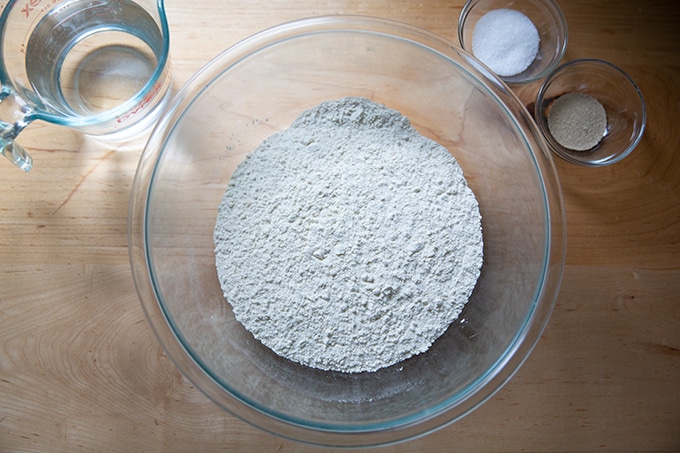
Pizza Dough Ingredients: Flour, Water, Salt, Yeast
OK, so now that we’re on the same page — a home oven requires a high-hydration dough for best results — let’s talk about how to make this simple dough.
The recipe below calls for flour, salt, water, and yeast, all of which we will discuss in more detail below. What you will not find in this recipe is olive oil, sugar or honey, or diastatic malt. Why? For one, simplicity. But more importantly, for this style of pizza, these ingredients do not help. Here’s why:
Olive Oil: Olive oil is added to dough recipes that call for long bakes because olive oil helps keep dough tender by “shortening” the gluten network. But for a short bake, such as the 5- to 6-minute bake called for here, olive oil mostly helps transfer heat from the cooking surface to the dough, which can result in too much browning.
Sweetener: Simply stated, a sweetener is not needed — the yeast, contrary to popular belief, does not need sugar to activate or thrive. Sweeteners, moreover, can cause the dough to ferment too quickly and they can also cause the dough to burn when baked at hot temperatures.
Diastatic Malt: Diastatic malt, an enzyme that converts the starches in flour to sugar, is added to pizza dough to promote good browning in the crust. Truthfully, I’ve never used it because I don’t like running around for odd ingredients that I don’t believe to be necessary. Ideally, with this recipe, the dough will spend some time in the fridge (see below: How to Make the Best Pizza Dough at Home: Two Tips), during which time enzymes in both the flour and the yeast will break down the starches in the flour into simple sugars, which will contribute both to flavor and to browning.
No-Knead Pizza Dough
To make this dough, you’ll whisk together flour, salt, and instant yeast. Then you’ll add water and stir with a spatula until the water is absorbed and you have a wet, sticky dough ball. That’s it. That is the beauty of a no-knead dough. Let’s take a look at the ingredients in more depth:
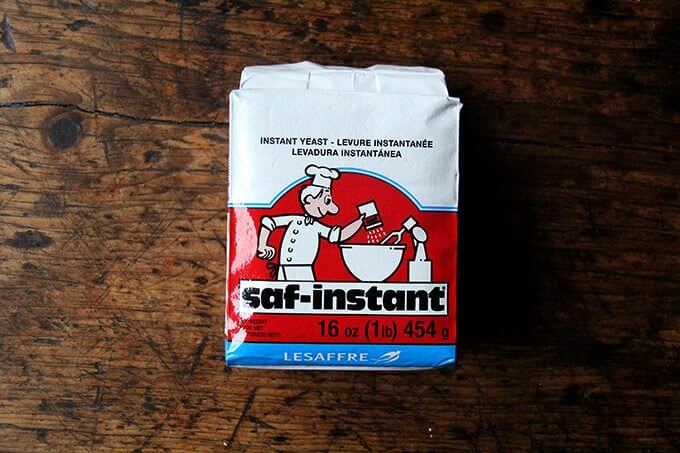
Yeast
Yeast is what will make your pizza rise, and my preference for all pizza and bread recipes is SAF Instant Yeast. The beauty of instant yeast is that you can stir it directly into the flour — no need to “proof” or “bloom” it.
Active Dry Yeast works here, too: Red Star Active Dry is my preference. To use active dry yeast instead, simply sprinkle it over the lukewarm water and let it stand for about 10 minutes or until it gets foamy before adding to the other ingredients.
Store yeast in the fridge or freezer for up to a year. These quart containers are great for storing yeast.
If you would prefer to make pizza with a sourdough starter, see this Sourdough Pizza Crust Recipe
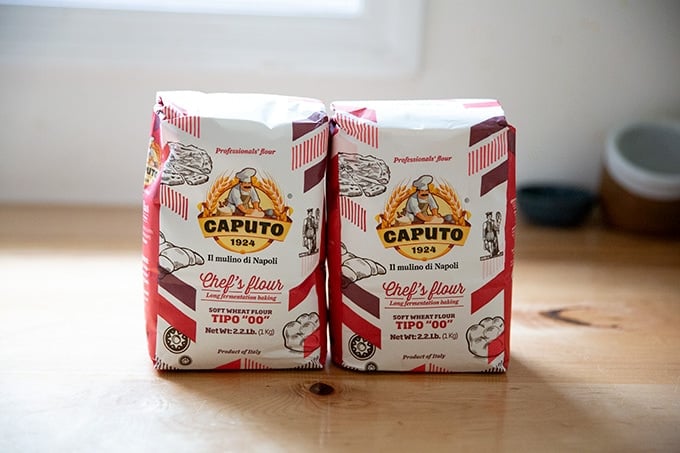
Flour: Tipo 00 vs. Bread vs. All-Purpose
Tipo 00 flour is the flour requisite in the production of D.O.C. Neapolitan pizza. Contrary to popular belief, the “00” is not an indicator of protein content. It refers, rather, to the fineness of the milling, “00” being the finest grade in the Italian classification system.
If you have never used tipo 00 flour, you may have enjoyed how nicely your dough handled, how easily it extended.
There was a period during which I used tipo 00 flour exclusively, but today I find I get just as good results when I use bread flour or all-purpose flour, King Arthur Flour being my favorite brand.
What is the difference between the two? Mostly the protein content. KAF bread flour has a higher protein content (12.7% protein) than the all-purpose flour (11.7% protein).
A dough made with bread flour as opposed to all-purpose flour will absorb slightly more liquid and will therefore be slightly stiffer. If you live in a humid environment and often find your dough to be too wet, using bread flour may help.
I must confess I am constantly changing my opinion about what type of flour makes the best pizza and this, I’ve learned, is because the flour itself is constantly changing from season to season and from year to year.
Moreover, every brand of flour absorbs water differently. For instance, King Arthur Flour’s 00 flour will absorb water differently than Giusto’s 00 Flour and Caputo’s 00 flour. Each of these varieties of 00 flour will taste differently, too. Same goes for different brands of all-purpose and bread flours.
In sum, the key is to use good flour: unbleached and unbromated flour. And I encourage you to experiment. What works best for me in my environment might not work as well for you in yours.
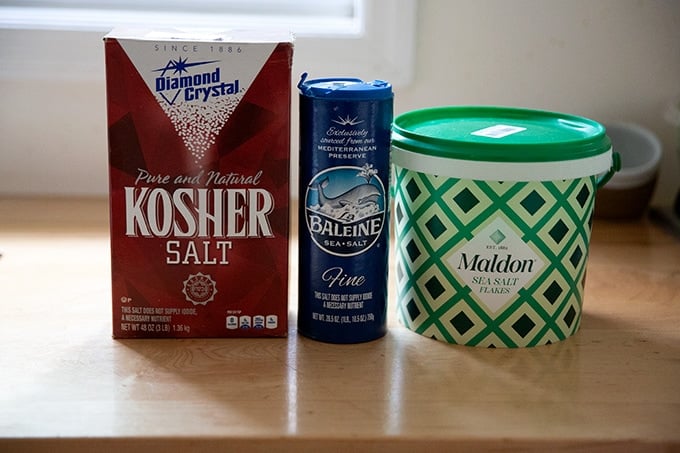
Salt
For pizza dough, my preference is Diamond Crystal kosher salt or Baleine fine sea salt, both of which dissolve quickly.
For finishing, I love Maldon sea salt. I finish nearly every pizza dough round I top with a drizzle of olive oil and a sprinkle of sea salt.
Water
I have no trouble using cold water from my tap, which I mix with boiling water to create perfectly lukewarm water (see recipe box for details). That said, if you suspect your water is adversely affecting your pizza dough, here are two tips:
- Use water that you’ve left out overnight to ensure any chlorine has evaporated.
- Buy spring water. In some places, letting water sit out overnight will not be effective.

Working with High Hydration Dough
OK, let’s review: to make great pizza at home, a high-hydration dough made with four good ingredients is best. Now let’s talk about how to deal with this super wet dough.
#1 Tip: Handle it gently.
“As soon as I began really paying attention to how I shaped my pizza rounds by taking care to use a gentle hand, I noticed a difference in the finished product. The air pockets pervading the unbaked round really affect the texture of the baked pizza.”
During the shaping process — the point at which you are stretching your ball of dough into a 10- to 12-inch round — take care to use a light touch (see the video above for reference). When you handle the dough minimally, you preserve the bubbles created during the rising. See these bubbles? …
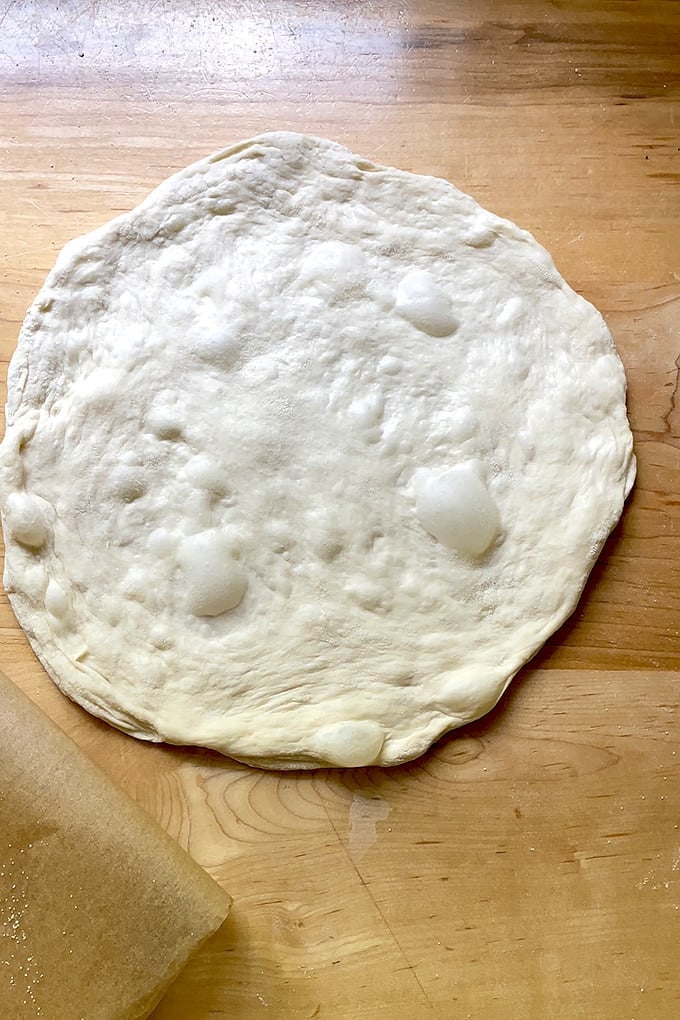
Those bubbles become these ballooned textures throughout the dough:

Two More Tips for Making Excellent Pizza at Home
Let’s review again, to make excellent pizza at home, you should:
- Use a high-hydration pizza dough.
- Use good quality ingredients.
- Handle the dough minimally.
Here are two more tips:
1. Invest in a Baking Steel
The single best and easiest/most affordable step you can take to make better pizza at home is to invest in a Baking Steel. In short, steel is a more conductive cooking surface than stone. This means heat transfers more quickly from steel to food than it does from stone to food. Why is this important for pizza? Serious Eats’ Kenji J Lopez Alt offers this explanation:
“How does the baking surface affect hole structure? Well those crust holes develop when air and water vapor trapped inside the dough matrix suddenly expand upon heating in a phenomenon known as oven spring. The faster you can transfer energy to the dough, the bigger those glorious bubbles will be, and the airier and more delicate the crust.”
I get the best results when I place my Baking Steel in the upper third of my oven, but every oven is different, so play around with placement till you find the sweet spot.
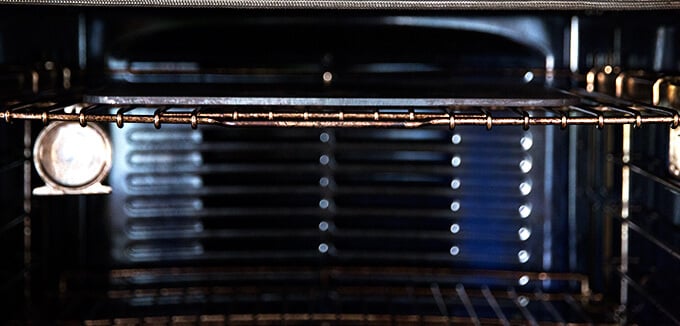
The beauty of the Baking Steel + a high-hydration dough.
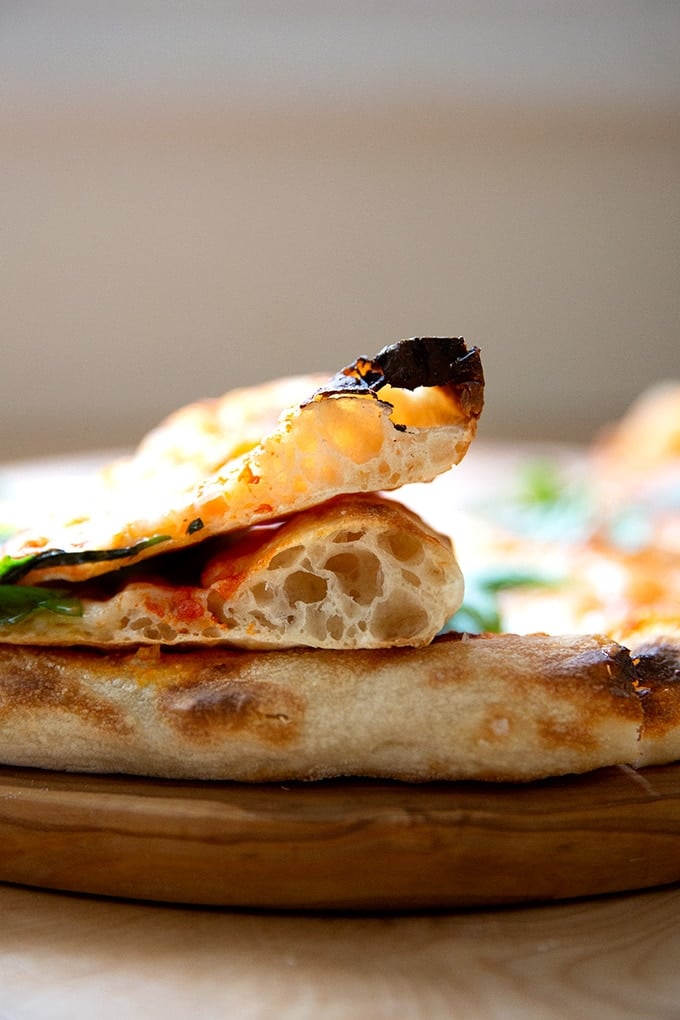
2. If Time Permits, Refrigerate The Dough
During a long, slow, cold fermentation, enzymes in both the flour and the yeast will break down the starches in the flour into simple sugars, which will contribute both to flavor and to browning. Moreover, during this time in the fridge, the dough will relax, making it easier to stretch.
Other Pizza Making Equipment
As always, for best results with bread or pizza recipes, use a digital scale. I cannot emphasize enough the importance of this. Measuring by weight is the only way to truly measure your ingredients accurately. It also, in turn, allows you to make meaningful adjustments to a recipe — i.e. reducing the water quantity — to make it work best given the flour you are using and your environment.
A pizza peel. You need a mechanism to get the dough round from your counter to your Steel. A peel plus a sheet of parchment paper makes this easy.
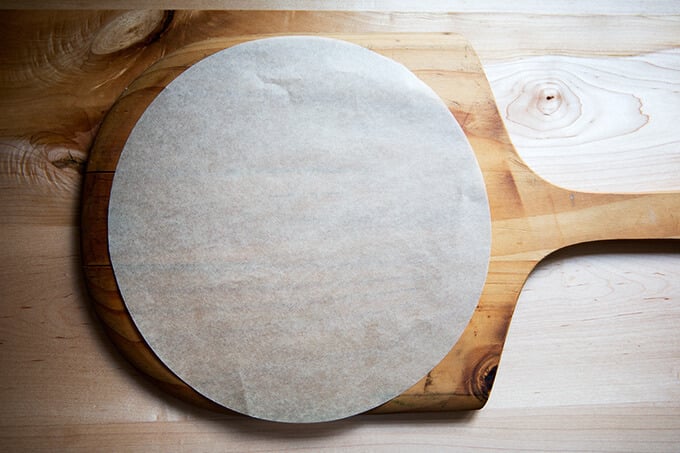
Parchment paper. For easy transfer of pizza from peel to Steel, my preference is to use parchment paper, which stays with the pizza in the oven. The alternative is to sprinkle your peel with cornmeal or flour or something to prevent it from sticking. These ingredients ultimately end up burning on the Steel or making a mess on your oven floor. No thank you. Recently, I’ve been buying these rounds, but standard rectangular sheets of parchment work just fine, too.
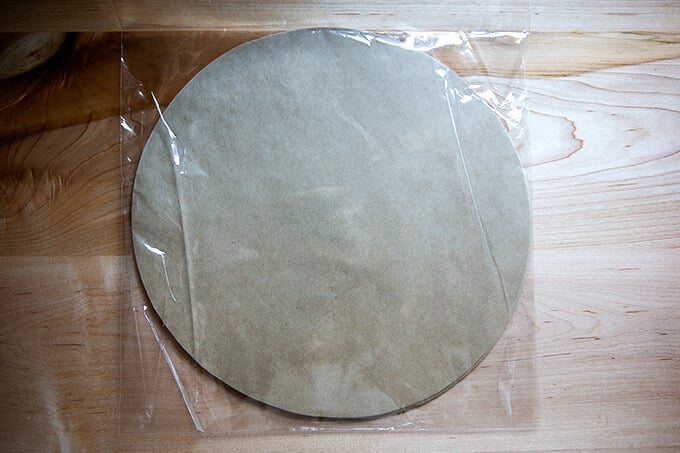
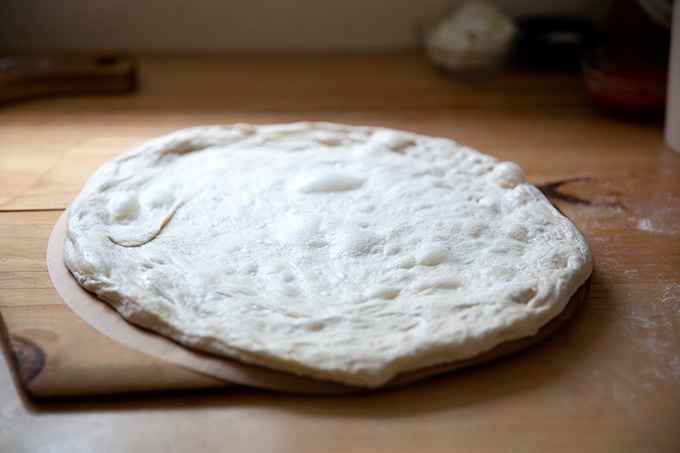
Quart containers: These are the handiest containers for all sorts of things (soups, stocks, stews, storing yeast) but especially rounds of pizza dough. Dough can stay in the fridge for up to 5 days or frozen for up to 3 months.

How to Make Pizza Dough, Step by Step
OK! Are you ready? Let’s make pizza dough:
Whisk together flour, salt, and instant yeast (SAF is my preference):
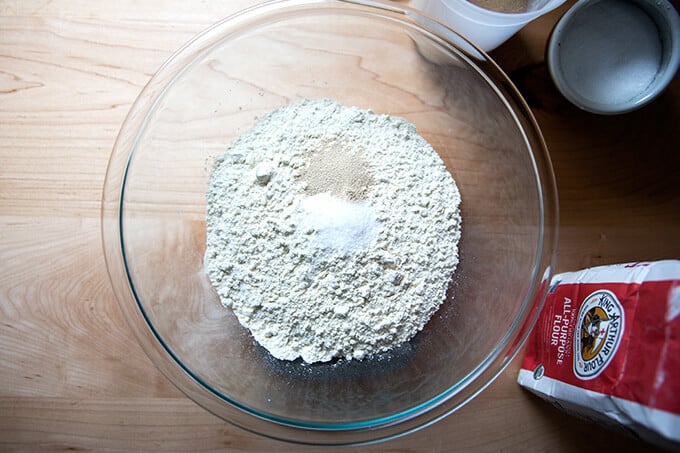
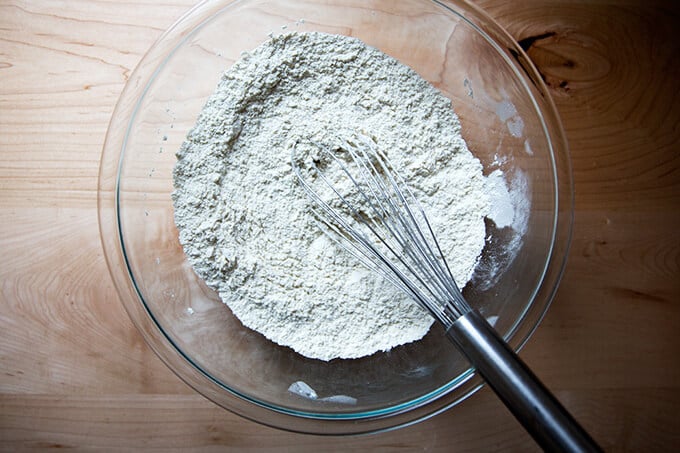
Add water, and …
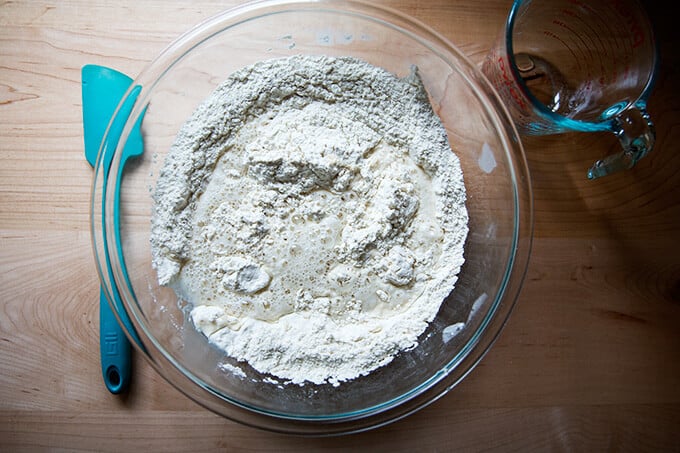
… mix to form a sticky dough ball:
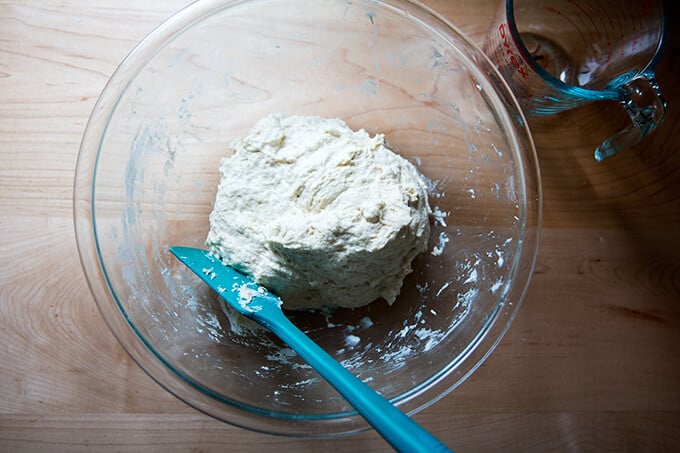
Let rise in a warm spot till nearly doubled, about 1.5 hours.
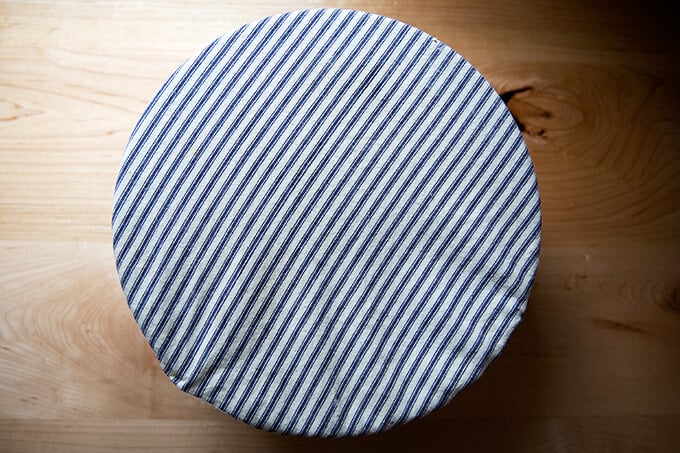
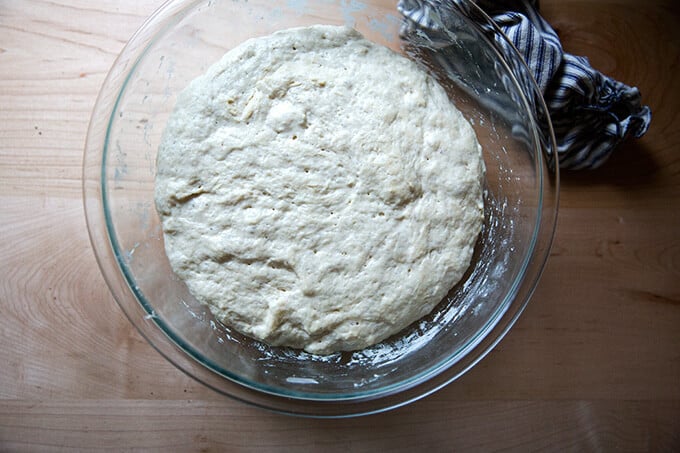
Turn out onto a floured work surface.
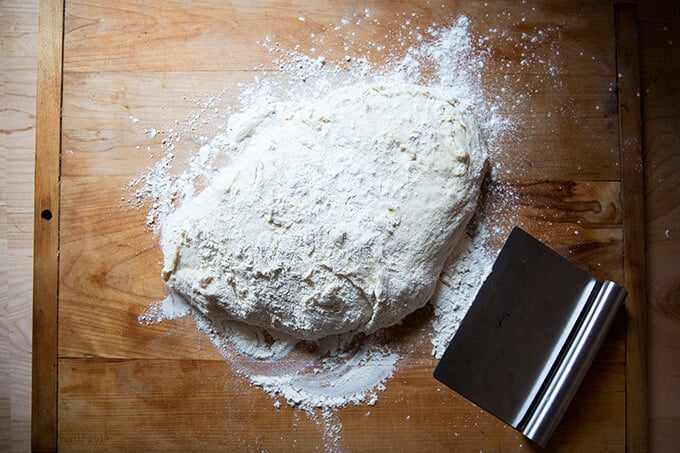
Divide into four portions and …
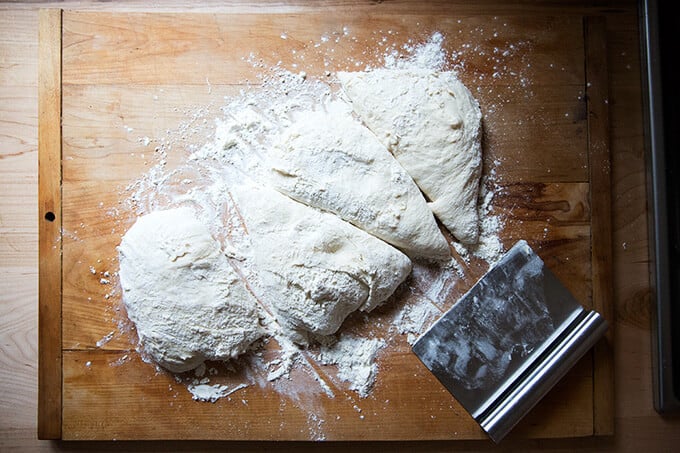
… ball up, using as much flour as needed.
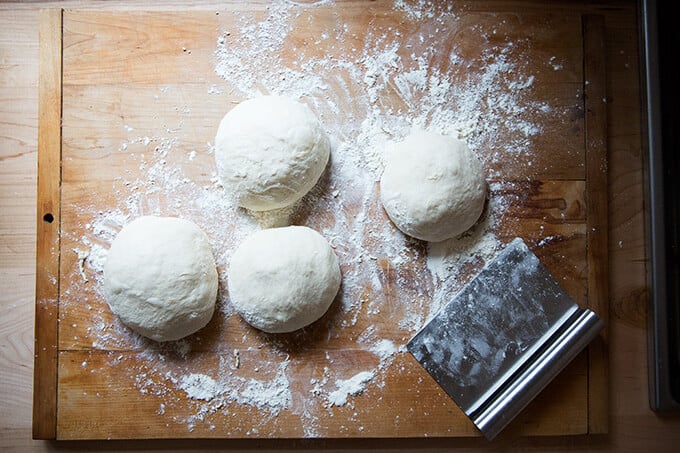
If you are baking pizza immediately, let the dough rest for another hour before shaping. Otherwise, transfer the balls to quart containers and stick them in the fridge.
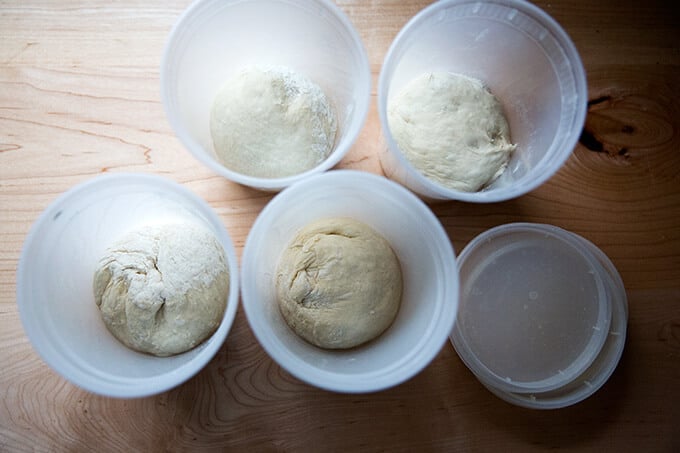
This is the dough after a night in the fridge.
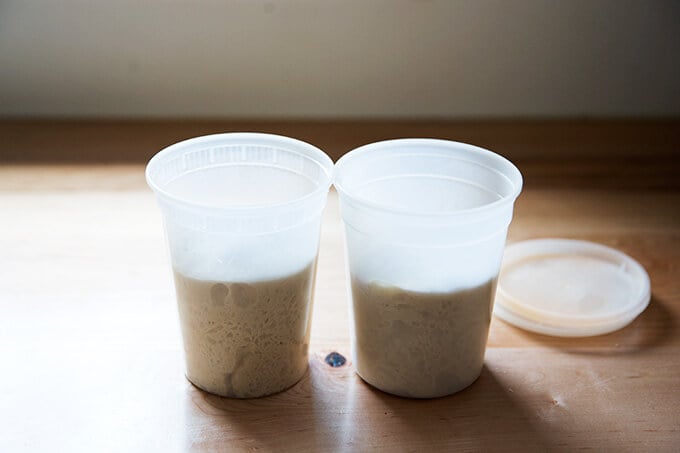
Turn the dough out onto a floured work surface and use your hands to cup the dough into a round.
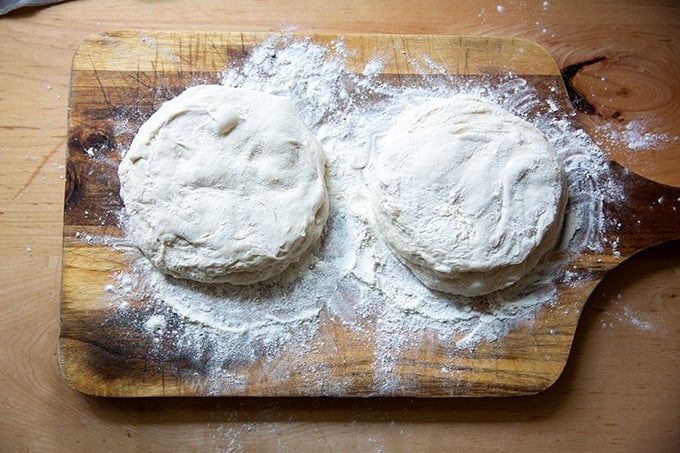
Let the rounds sit for about an hour covered in a towel.
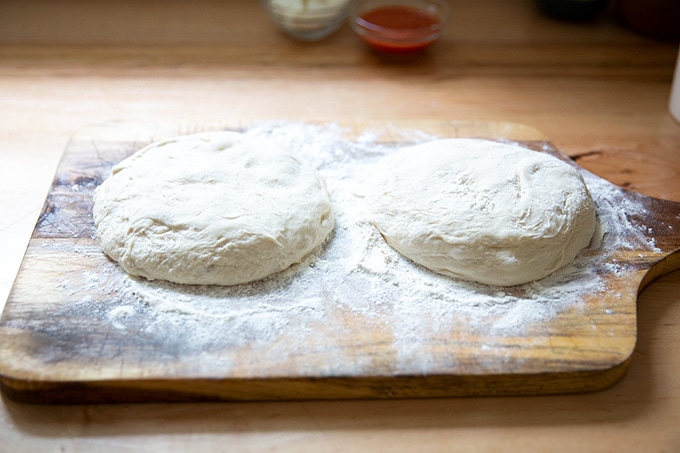
Gently stretch a round into an 11-inch round (roughly).
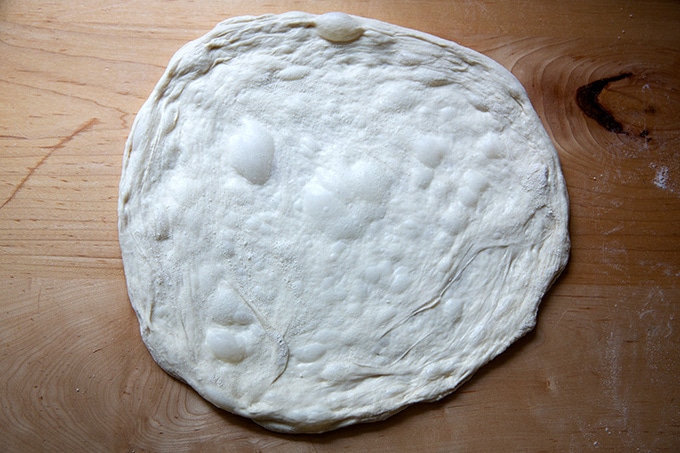
Transfer the round to a peel lined with parchment paper.

Get your toppings ready. For a classic Margherita pizza, youll need tomato sauce, mozzarella, and fresh basil.
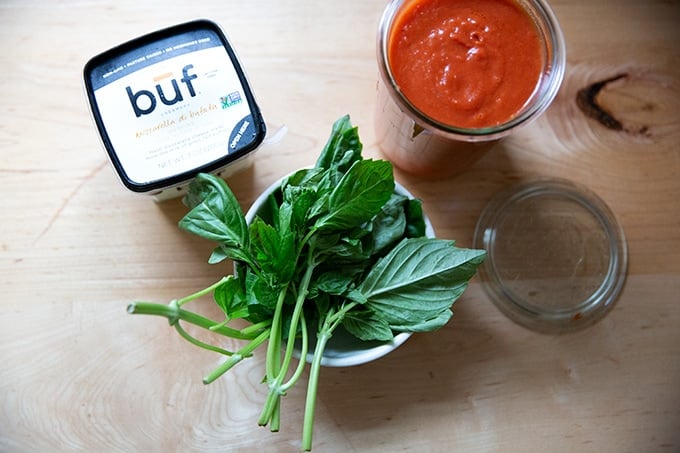
Spread about 2 ounces of tomato sauce over your dough.
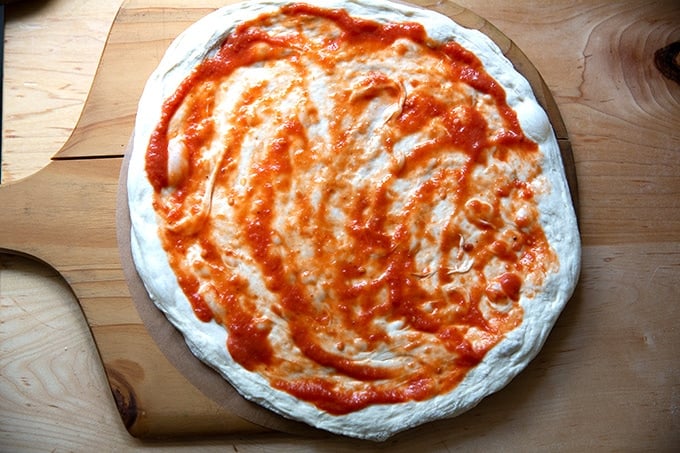
Top with about 3 ounces of mozzarella. Drizzle lightly with olive oil and sprinkle with sea salt.

Bake on a preheated Baking Steel at 550ºF for 5 to 6 minutes. Shower with fresh basil out of the oven.

The beauty of the Baking Steel + high hydration dough: oven spring.

Timing
As noted above, you can mix and use this dough today — it does not require a long, slow rise. If you want to make it ahead of time, however, and stick it in the fridge until pizza night, that works, too:
- Make it Tonight: Plan on 3 hours start to finish from when you mix your dough to when you turn out a freshly baked pizza.
- Make it Tomorrow (and beyond): Method 1: Mix your dough today, let it rise for 1.5 hours (roughly). Portion it into 4 balls; then transfer to the fridge for up to 3 days (or even longer). When using dough you’ve stored in the refrigerator, remove it one hour prior to baking.
- Make it Tomorrow (and beyond), Method 2: Mix your dough, cover the bowl with an airtight lid or seal it tightly with plastic wrap, and immediately transfer it to the fridge. When you are ready to bake, remove the dough from the fridge 60 to 90 minutes prior to baking, portion it into 4 balls; then transfer as many as you wish to bake to a well-floured board. Transfer the remaining balls to the fridge for up to 3 days (or even longer). When using dough you’ve stored in the refrigerator, remove it 60 to 90 minutes prior to baking.
The refrigerator is your friend: The two quart containers on the left are holding freshly portioned dough; the two quart containers on the right are holding dough after 2 days in the refrigerator. Look at those bubbles!:
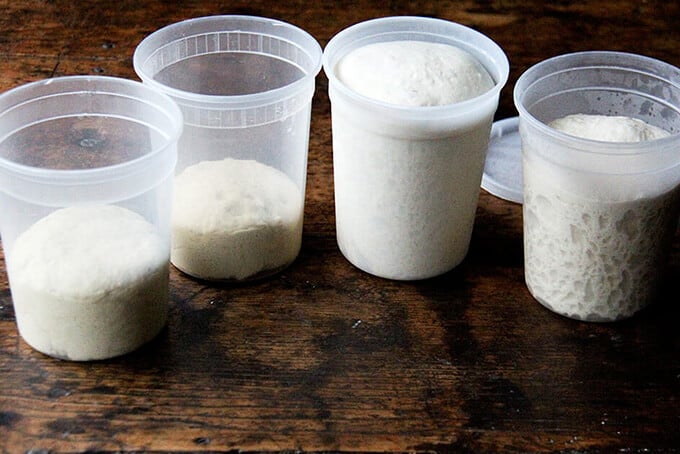
Can You Freeze Pizza Dough?
Yes! This has been a game-changer. To freeze pizza dough, make it through step 4 in the recipe below or until after you transfer the portioned rounds to quart containers. At this point, transfer the quart containers to the freezer for as long as 3 months. To thaw, remove a container (or more) and let thaw in the refrigerator for 18 to 24 hours or thaw at room temperature for 4 to 8 hours. Then, proceed with the recipe.
PS: Easy, Homemade Pita Bread Recipe
Four More Pizza Styles to Try
Find ALL the pizza recipes here. Below are links to four different styles of pizza to try.
FAQs & Troubleshooting
Why is my pizza dough too wet?
It is possible that given your environment and the type of flour you are using, you are using too much water relative to the amount of flour. The fix is simple: reduce the amount of water. Ideally, you are measuring with a scale, so you can ensure you are measuring accurately and making meaningful adjustments. Try holding back 50 grams of water and seeing if that helps.
That said, please read above about the importance of using a high-hydration pizza dough in a home oven. If your dough, upon being mixed, is unable to form a sticky dough ball, you likely need to reduce the water. Reference the video for dough texture.
Why is my pizza dough soggy?
There are several culprits here:
- too much sauce, cheese, and/or toppings
- oven not hot enough
- too short of a baking time
Solutions:
- Invest in a Baking Steel. Read why above.
- Try laying the cheese on top of the dough; then the sauce. The cheese might provide some insulation from the sauce, thereby preventing the dough from getting soggy.
- Consider employing a parbake: bake your pizza “naked” for one minute; then continue baking for 4 to 5 minutes more once topped.
- Try using semolina on your peel.
- Before stretching your dough ball into a round, slick it lightly in a bit of olive oil.
- Use a lighter hand when topping.

Pizza Night
My cookbook, Pizza Night, which includes 52 pizza and 52 salad recipes, one pair for every week of the year, as well as five simple desserts is now available for preorder 🍕🍕🍕
It’s organized seasonally and includes recipes for the home oven, outdoor oven, the grill, Sicilian-style, Detroit-style, grandma-style, skillet pizzas, gluten-free, and more. There are both yeast and sourdough recipes for every style of pizza in the book.
Get your copy here: Pizza Night.

Simple, 4-Ingredient Homemade Pizza Dough
- Total Time: 2 hours 35 minutes
- Yield: 4 pizzas
Description
If you love pizza with ballooned and blistered edges and a crisp but pliable crust, this is the pizza dough recipe you’ll come back to again and again. And it’s easy to make—the pizza dough is no-knead, made with 4 simple ingredients, and doesn’t require special flour. Video guidance below.
**Attention Pizza Fans**: My new cookbook, Pizza Night, is available for preorder.
NOTES:
This recipe yields 4 rounds of dough. Recipe can be halved; dough can be refrigerated for up to five days. I refrigerate individual rounds of dough in quart containers.
Dough can be frozen, too. After the first rise and after you transfer the portioned rounds to quart containers, this is your opportunity to freeze. Transfer the quart containers to the freezer for as long as 3 months. To thaw, remove a container (or more) and let thaw in the refrigerator for 1 day or thaw at room temperature for 4 to 8 hours. Then, proceed with the recipe.
Yeast: If you need to use active dry yeast instead of instant, sprinkle it over the lukewarm water and let it stand for about 10 minutes or until it gets foamy before adding to the other ingredients.
Warm place to rise: Here’s a trick for making the perfect warm spot for the dough to rise. Turn the oven on and let it preheat for 1 minute; then shut it off. The temperature will be between 80° F and 100° F. you should be able to place your hand on the oven grates without burning them.
Flour: You can use bread flour and all-purpose flour here but if you live in a humid environment, I would consider using bread flour if you can get your hands on it. If you are in Canada or the UK, also consider using bread flour or consider holding back some of the water (see next paragraph). Reference the video for how the texture of the bread should look; then add water back as needed.
Water:
I find the sweet spot for me to be about 418 grams of water, which is roughly an 82% hydration dough. If this is too high, try using 400 grams of water or even 395 grams of water, which will lower the hydration to 77%.
As noted above, this is a variation of the peasant pizza dough recipe in my cookbook. If you are unfamiliar, the peasant bread dough is a very wet, no-knead dough. The key when handling it, is to use as much flour as necessary to keep it from sticking to the board and your hands. That said, you absolutely can start with less water to make the dough more manageable. If you live in a humid environment, if you live abroad, if you are using all-purpose flour or Tipo 00 flour, if you dislike handling wet doughs, consider starting with 400 to 425 grams of water. Add water as needed to get it to the right consistency (reference the video).
To make lukewarm water, use 1 part boiling liquid to 3 parts cold liquid. For 2 cups of lukewarm water, use 1/2 cup boiling, 1 1/2 cups cold water. You don’t have to be so precise, but using this rough ratio will give you perfectly lukewarm water.
Parchment: These rounds are so handy.
Toppings: In the notes below the recipe, find the toppings for a classic Margherita pizza and for a kale, parmesan, and crème fraîche pizza. See above for 6 other favorite pizza recipes.
Ingredients
- 4 cups (512 g) bread flour or all-purpose flour, plus more for assembly
- 2 to 3 teaspoons (12 g) kosher salt
- 1 teaspoon (4 g) instant yeast
- 1.75 to 2 cups (400 to 454 g) lukewarm water, see notes above
Instructions
- To make the dough: In a large bowl, whisk together the flour, salt, and instant yeast. Add the water. Using a rubber spatula, mix until the water is absorbed and the ingredients form a sticky dough ball. Pour a drop or two of oil over top and rub with your hands to coat.
- Cover the bowl with a damp tea towel or plastic wrap and set aside in a warm spot to rise for 1 to 1 1/2 hours, or until the dough has doubled in bulk.
- If you are baking the pizzas right away (as opposed to refrigerating the dough for another day), place a Baking Steel or pizza stone in top third of oven and preheat oven to its hottest setting, 550°F. Be sure the Baking Steel heats for at least 45 minutes once the oven temperature reaches 550ºF.
- Cover a work surface or cutting board liberally with flour — use at least 1/4 cup and more as needed. The dough is very wet, so don’t hesitate to use flour as needed. Turn the dough out onto your floured surface and use a bench scraper to divide the dough into 4 equal portions. With floured hands, roll each portion into a ball, using the pinkie-edges of your hands to pinch the dough underneath each ball. If you are not baking the pizza the same day, transfer each round of dough to a plastic quart container (or something similar), cover, and store in the fridge. (At this point, transfer the vessels to the freezer for up to 3 months. See notes above for thawing.) If you are baking right away, let the balls sit on their tucked-in edges for at least 30 minutes without touching.
- To Make the Pizzas: If using refrigerated dough, pull out a pizza round from the fridge one hour (or even 90 minutes if time permits) before you plan on baking. Dust dough with flour and place on a floured work surface. Cover the dough with a towel or plastic wrap to prevent it from drying out. (Update: I now let my dough balls rest in a lidded vessel or a pan covered with plastic wrap to ensure the dough balls do not dry out during the 60-90 minutes at room temperature.) Let rest untouched for 60 to 90 minutes.
- Handling the dough as minimally as possible, shape the dough into a 10″–12″ round. If the dough has proofed sufficiently, you should be able to pick it up and stretch it very easily using the back of your hands. Lay a sheet of parchment paper on a pizza peel, and pour a few drops of oil into the center of it. (Note: the oil is optional. It’s especially helpful if you find shaping dough using the backs of your hands tricky.) Transfer the dough round to the parchment-lined baking peel.
- Top pizza as desired or to make the Margherita pizza: spread 2 ounces of tomato sauce over your pizza dough. Top with 3 ounces of mozzarella. Drizzle with olive oil. Season with a pinch of flaky sea salt. Shimmy the pizza, parchment paper and all into the oven. To make the kale and crème fraîche pizza: Place the kale in a small bowl, drizzle lightly with olive oil, season with sea salt, and toss with your hands till the kale is coated in oil and salt. Spoon crème fraîche over the dough leaving a 1/2-inch border or so—I use 1 to 2 tablespoons per pizza. Sprinkle with the garlic and a handful of the grated Parmigiano Reggiano. Top with the kale. Shimmy the pizza, parchment paper and all into the oven.
- Bake pizza until top is blistered, about 5 minutes. Transfer to cutting board. Shower basil over the pizza Margherita. Cut and serve. Discard parchment paper.
Notes
Margherita Pizza:
- 2 ounces tomato sauce, such as this one
- 3 ounces fresh mozzarella (if using buffalo mozzarella, drain before using)
- olive oil
- flaky sea salt
- fresh basil
Kale & Creme Fraiche Pizza:
- extra-virgin olive oil
- a couple handfuls of baby kale
- 1 to 2 cloves garlic
- Sea salt, such as Maldon
- 2 tablespoons crème fraîche
- grated Parmigiano Reggiano, about 1/4 to 1/3 cup
- Prep Time: 2 hours 30 minutes
- Cook Time: 5 minutes
- Category: Pizza
- Method: baked
- Cuisine: American, Italian
This post may contain affiliate links. Please read my disclosure policy.

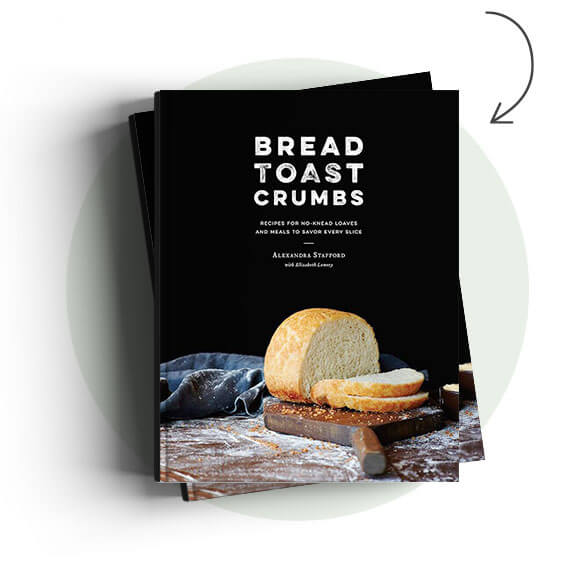




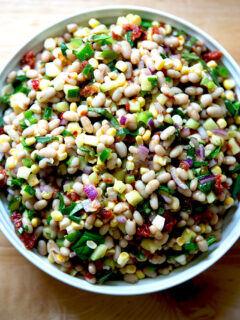
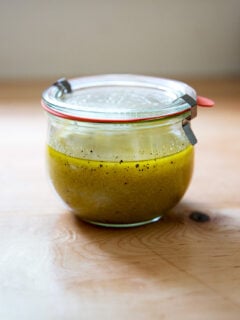






601 Comments on “Simple, 4-Ingredient Homemade Pizza Dough”
Yep! Best pizza dough for me. Overnight rest. Baked in Breville countertop oven @ 480
( highest temp) on stone that was heated for a 1/2 hour. Did a regular old pepperoni pizza. Yummy good! Made half of recipe so I have another dough ready to go. Just husband and me at 77 years old. It’s never too late to learn to make great pizza. 😊
Great to hear, PattiAnn! I just got one of those Breville countertop ovens. I will try your settings the next time I make pizza, which will be tomorrow 🙂 Thanks so much for writing!
Hi Alexandra! I have tried this recipe a few times now and the dough comes out perfect every time! Would this work for calzones? Thanks!
Great to hear, Sarah 🙂 🙂 🙂 I think it would. I might consider lowering the hydration slightly just so that the dough is a little more manageable to work with. Maybe hold back 50 grams of water or so?
It’s no surprise to me that this is yet another stellar recipe, Ali! I baked my pizza at 425F on a parchment lined baking sheet, so it didn’t get the amazing char that is normally expected of pizza. However, it was still absolutely delicious. I’ve also used this dough for stromboli, which admittedly is a challenge given the high hydration, but it’s doable! I used Jenn Segal’s recipe from Once Upon a Chef as a guide. I also made a vegan version with Daiya mozzarella, spinach, marinated artichokes (patted dry) and sauteed peppers and onions. For those wondering about calzones, it should definitely work (and would be significantly easier than stromboli)!
I am so happy to read all of this, Jackie! And honestly, more and more, I think char is over-rated — a little blistering is nice; significant burnt portions are not. I am definitely going to check out Jen’s stromboli guide — love her! — and will look out for that vegan mozzarella, too. I get questions all the time about vegan substitutes. Thank you so much for writing and sharing all of your notes!
Hi Ali,
Since the pandemic began, I started making pizza every Friday night. After using frozen pizza dough from the store (not bad) I have been trying out different pizza doughs.. many failures, but…..this is wonderful. Made dough today using all purpose KAF and our first pizza for two tonight. My husband is a traditionalist and wanted sauce and toppings. Used my ancient pizza stone in a 485 oven. Best homemade pizza ever!!! Thank you! Thinking I might need a steel…….
So nice to read this Susan! I think you do need a Steel 🙂 🙂 🙂 Every time I make pizza (which is multiple times a week), I am so grateful for it. We made pizza last night as well. Sauce and cheese on one, and then a white pie with arugula scattered on top out of the oven. I love pizza night!
Hi Ali,
How do I get my pizza dough to rise?
I’ve made your pizza dough many times, and with ample success, but it never rises properly. It doesn’t double in volume on the 1st proof, nor puff up after its 3 day cold ferment. I always use King A. Bread flour (I like the chew) and use the fill and level method for measuring flour. I may not be doing anything wrong, but I always wondered why it doesn’t double in volume as expected. Any advice is greatly appreciated
Hi Sheena! What type of yeast are you using? I would definitely recommend investing in a scale. It sounds as though you are committed to making good pizza. It will make all the difference. This one costs $12.50
This is our favorite dough! Has anyone tried to use it for pizzas on the grill?
Hi Lilli! I have not, but I think it would work. You might consider lowering the hydration slightly — hold back 1/4 to 1/3 cup water or so. I think it will make the dough more manageable on the grill.
This pizza dough is fantastic! I’ve made it more times than I can count in the past couple of months since discovering it. I’m in Canada and I always use bread flour for this recipe — turns out great every time. I personally think the crust is a little bit underseasoned as written, so I like to increase the salt to 15g. Regardless I’m blown away by this recipe and have been recommending it to so many friends! Such incredible results even without a baking steel — here’s what works for me: I let my oven preheat at the max temp (500 on my dial, but my oven runs hot by about 50F) for 45-60 minutes. Then I lightly coat a very dark-coloured pizza pan with olive oil, transfer the stretched dough onto that, add my toppings, and bake it on the bottom rack for about 6-7 minutes. Can’t wait to get a baking steel one day and try it that way too! Thanks for an amazing recipe!
So great to read all of this, Ruth! Thank you so much for writing and sharing your notes. I love that you use 15 g salt — I have actually been upping the salt as well recently. And I also love that you are getting great results without a Steel … that’s what it’s all about: using what we have! Thanks so much for writing.
Thanks for your reply Alexandra! Wanted to come back and add a couple wee updates to my original comment.
I recently acquired a baking steel and the results with this recipe are fantastic! It’s been fun experimenting with the steel for other bakes as well.
Also, I had a leftover round of dough in the fridge the other day that had already been in there fermenting for a while so I wasn’t sure whether I could freeze it for a future pizza adventure at that point. Instead, I decided to make a mini focaccia! I love your focaccia recipe so I followed those directions/visual cues and just used a standard loaf pan for the one portion of dough. It turned out great!!
Thanks again for such a fantastic recipe 🙂
Fun! So great to hear all of this. I’m so glad you got a Steel and are liking it. And I think you made the right call regarding not freezing the dough that had been fermenting already for several days. Yay for focaccia and loaf pans 🙂 🙂 🙂 Thanks for the update!
I have been making this recipe for months now and absolutely love it. I am using KAF All Purpose flour but was wanting to try their 00 flour. Can I use the same amount of flour as listed in the recipe, or do adjustments need to be made? We are really enjoying our Friday Pizza Nights.
So nice to read this, Claudia! I, too, have been wanting to try their 00 flour … let me know how you like it 🙂 Yes, you should be able to use the same amount. You may want to consider holding back some of the water, especially if you live in a humid environment, but otherwise, the recipe should work just the same. Thanks for writing!
Hi there. I need to make a bunch of pizzas for a bunch of kids and I wonder if there’s any way to make this in a sheet pan?
I normally do cast iron or grilled pizza just for my family but I need to be able to make a larger quantity all at once..
Hi Erica! Yes, you definitely can. I never am as satisfied with the crust when the dough is baked on a sheet pan, but I don’t think kids are as fussy when it comes to crust texture.
One thing I’ve been doing this summer is grilling pizza dough — I lower the hydration of this recipe — just for 30 seconds or so a side, just until I have nice grill marks on each side. I do this earlier in the day. Then at dinner time, I top the grilled rounds and bake them in the oven until the cheese melts. The crust gets nice and crisp.
What did you end up doing? Apologies for the delay here.
I would love to try this method! Do you put any type of oil on the dough before putting it on the grill to avoid any sticking? Thank you!
I use olive oil! Lower the hydration of the dough considerably: try 340 grams water.
Hi Ali,
The parchment rounds you use say they can be used in an oven up to 425 degrees, yet your recipe calls for a 550-degree oven. Could you please clarify? Thank you –
Hi Marion! I have never had an issue with parchment catching on fire at 550ºF, and I’ve left paper in by accident, only to open the oven to find them nearly burnt to a crisp, but not fire. Never use it under the broiler. Otherwise, it will be safe in your oven. These are the parchment rounds I’ve been using and loving. Going to update the link in the post now.
I love baking, and I bake a lot, but pizza has always been my weak spot, I could never make it taste just right, but this recipe is a life changer. Thank you so much for this recipe! I am your biggest fan from now on.
For people searching in the comments trying to decide if they should try this recipe, just do it! It is the easiest and the best pizza ever! 🙂
So nice to read all of this, Aleksandra 🙂 🙂 🙂 Thanks so much for taking the time to write 🍕🍕🍕🍕🍕
Can I use regular yeast rather than instant? Thanks
Yes! You’ll want to activate first over the lukewarm water. Just sprinkle it over the top and let it sit for 15-20 minutes; then proceed with the recipe.
Hi Alexandra!
I’ve been making your sour dough breads, monkey bread, and focaccia breads…all of them are fantastic! I’m totally addicted to baking now. 🙂
I’d like to try to make pizza on my weber charcoal grill. I will be using a pizza stone on the grill. Any tips or recommendations on how to successfully pull this off? Do I just follow the oven method you have provided for the pizza?
Thank You!
Hi! Great to hear all of this, thank you 🙂 🙂 🙂
I have to be honest, I have not had the best luck putting my Baking Steel on my gas Weber grill … obviously not the same exact thing you are doing, but similar. The trouble I always run into is that the bottom browns too quickly and then burns before the top is done. And the top never cooks properly… it’s tricky. If you give it a go, I’d love to know your experience. Wish I had more helpful notes to share!
Hi Ali. We’ve had the same experience on our grill. Lately we’ve put the pizza steel on top of our cast iron pan to lift it up to catch more top heat. It helps. Our next step is to try to use bricks on other side of the steel and put a sheet metal pan on top to emulate the smaller size of a pizza oven. We love cooking/eating outside and Friday night pizza is our favorite. Just need to figure out how to make it right without paying $$$$.
I’m so glad I’m not the only one who has found this method problematic! I like your “lifting” idea with bricks and/or a skillet. Very smart. It’s almost like we need two Steels, one on the grill, one propped up by bricks, but as you note: $$$$
I am working on a grilled pizza dough recipe/method that calls for cooking directly on the grates. It’s lower hydration (67%), and I’m liking the method so far. Stay tuned!
Hi,
In my last batch of this pizza dough- the crust was thin and cracker like. I’d love your input! Eager to try my next batch!
Kellie
Hi! Questions:
Are you using a scale?
What type of flour?
What type of baking vessel?
I suspect the solution will be simple: use less water from the start. It is such a high-hydration dough and it can easily get stretched too thin, which can lead to a too-thin crust.
Hi Ali, I have a question about timing for this dough. If I want to make the dough and freeze it, can I mix it, divide it into balls, and put it directly into the fridge/freezer? Does it need to rise at room temp before I do this? Your timing Method #2 in the recipe made me wonder if the bulk rise at room temperature was necessary if you don’t plan to use the dough for a while. And in that case, how long would it need to rise once I take it out of the fridge when I’m ready to use it? Thanks for clarifying!
Hi Erin! That is a great question. I actually have never tried dividing the dough into balls immediately after mixing it. Theoretically, it should be fine as long as the yeast is evenly dispersed in the dough. For reasons I cannot explain, it makes me a little nervous… I feel like even a 1-hour rise or 45-minute rise if you are pressed for time would be better. Once you remove the dough from the fridge, it will need about an hour at room temperature covered with a tea towel or in an airtight vessel to prevent the dough from drying out.
Congrats on your pizza book project! I wonder if you will try a St. Louis-style pizza, which has a “cracker crust” (just very thin). It is so totally different than the thick pizza dough. St. Louis pizzas (some) also use a controversial processed cheese called Provel. I grew up with it so I like it and often don’t care for very thick crusts. But many people disagree. (Cook’s Country magazine once tried to duplicate, fyi.)
Thank you, Leslie! I am not familiar with this style, but it sounds delicious, and I will definitely look into it. Love the idea! I have heard of Provel on one of the pizza podcasts that I listen to… I’ll go back and find that episode. Thanks so much for writing!
Hi Alexandra. I have not yet made this pizza dough recipe, and I will soon. I’m an avid mozzarella maker and my pizzas are thin, but I want to make your high hydration recipe. I have a Breville Pizzaiolo oven. Looks like their Breville counter oven, but this is specifically for pizza and heats up to 750 degrees. There are also manual settings, which I have yet to use. I use their Wood Fired setting. Can I make this in the Breville Pizzaiolo at this high temp, or do I need to use the manual setting and cook at 550 degrees? Thanks. I just love your recipes and it seems that many people love this particular recipe. Thanks.
Hi Carolyn! I am so impressed by your mozzarella-making! That is something I have been meaning to try my hand at… one day.
I also have that Breville Pizzaiolo oven, and I have a few thoughts in terms of having success with it. I think the key with it for making Neapolitan-style pizza is to use a smaller amount of dough (roughly 220 grams). Most of my dough rounds are just a wee too big for it (closer to 245 grams). But when I use the right amount of dough with the right settings, it works beautifully. For settings: I do use the manual settings, and I set the deck temp and the top temp to 750ºF. I bake it for two to three minutes… definitely keep an eye on it.
A few other thoughts: You may want to consider reducing the hydration of this pizza dough or using the smaller quantity suggested. In my outdoor pizza oven I’ve been using a 67% hydration pizza dough, but I have yet to try that with my pizzaiolo countertop oven.
Let me know if you have other questions!
Thanks so much for replying. This is very helpful. There was a typo in my original query to you. I am an avid PIZZA maker, not a mozzarella maker. One day i will try that. But I do make pizzas once a week. I will try to manual setting on the Breville Pizzaiolo next time, and yes, I do use a smaller dough ball for this machine as the deck is smaller than a pizza stone you would use in a home oven. My dough balls are 7oz. and about 11″ in diameter. I really do enjoy your site. And looking forward to your pizza book! Good luck with it.
One more important question with this high hydration dough. When making it in the Breville Pizzaiolo oven, do you still place the dough on parchment paper? As the oven temp will be 750, and the parchment package states it is good up to 450 or 425, can you still use the parchment? Thanks Ali.
Hi! You actually can use parchment. It will become very brittle and charred, but mine has yet to catch fire, and using it does make the transfer seamless. You can also use it for the transfer, then open the oven a minute later and pull out the parchment.
What I do find tricky about these ovens as well as the Baking Steel is that if you don’t use parchment, all of the flour you use to prevent sticking on the peel, burns in the oven, and it’s hard to clean.
I have been using a 67% hydration pizza dough in my outdoor pizza oven, and I have yet to try that in my Pizzaiolo, but I will soon, and I think it will be easier to transfer without parchment paper. I have gotten better about using a flour-dusted peel — I use a 50-50 mix of rice flour and ap flour — for the transfer, so I will try that, too.
For this recipe, a 67% hydration dough would be about 345 grams water. You’ll need to knead it briefly in the bowl. Wwith these stiffer doughs, I like to do a set of stretches and folds 30 minutes after mixing.
Thanks so much for this information. Very helpful. Will report back after I make the dough and pizza in the Breville Pizzaiolo!!
I can’t wait to try this recipe, with the kale and all! I do have a suggestion when transferring dough from pizza paddle to oven if you don’t want to use parchment. Dust the pizza paddle with cornmeal and it will slide right off onto your stone.
Great tip, Lisa! Thanks for sharing.
Am making this recipe right now and reading ahead in the instructions for next steps. You mention using a baking “peel” and a pizza “peel” twice. What is that?
Hi! Can you point to where these are in the post … or where the point of confusion is? I’m worried I’m using the words incorrectly.
It should be “pizza peel”, which is the wooden paddle that you use to transfer the unbaked pizza to the hot cooking surface.
The Baking Steel is the hot cooking surface.
Used this recipe for a pizza party I had over the weekend. I am an experienced pizza dough maker..do this kind of party frequently. Decided to try Ali’s recipe (used 00 Caputo flour which I always use – buy it from Amazon) – and WOW. sooo easy to mix in a bowl rather than clean the KitchenAid mixer. My guests loved the crisp crust with the “pillowy” outside crust. A BIG hit. A keeper recipe from now on (sorry Tyler Florence – I am moving on from your recipe which was my go-to for years!). I used a pizza oven with the gas/propane attachment. LOVED the results. Reliable and yummy. I made extra dough to freeze…will report back how that works when i use it….Thank you Ali!
Yay! So wonderful to read all of this, Kris! I have been very into the Caputo blue bag of 00 flour (labeled “pizzeria”) — is that what you use? Or the red bag? Either way, I’m so glad you had success in your outdoor pizza oven. If you have a moment, I’d love to know how much water you used.
Thanks so much for writing 🍕🍕🍕🍕🍕
When I measure 1 tsp instant yeast and weigh it I don’t get up to 4 g until I have almost a tablespoon. I just went ahead and just used a tsp measurement – there were bubbles etc and the pizza was fairly good after 48 hrs in fridge
This is it, the easiest and yummiest pizza dough! It works everytime and everytime I make it when people are coming over, they’re super impressed. Thanks Alexandra.
Great to hear, Ming! Thanks so much for writing 🙂 🙂 🙂
My new favorite homemade pizza crust! It worked beautifully and I loved the texture. Thank you for a great recipe.
Great to hear, Dawn! Thanks so much for writing 🙂 🙂 🙂
I made this today and it’s excellent. I couldn’t bake right away so refrigerated the dough about 2 hours, then let rest at room temp about an hour before baking. I don’t have a steel or stone so baked one on a light metal pan at 450 and another on a dark metal pan convection 425. Both worked well. This is my new go-to pizza dough!
Wonderful to read this, Kate! Thanks so much for writing 🙂 🙂 🙂
10/10! This is my go to pizza dough from now on. I had been searching/trying recipes for about 2 years. My search is officially over! Thank you!
Wonderful to hear this, Stacy! Thanks so much for writing 🙂
Hi Ali. I would like to make this pizza dough now, but I am running low on Tipo 00 Flour. Would it work if I used half Tipo 00 and half KAF all purpose or KAF bread flour? If so, which would be better to use? Thanks so much!!!
Absolutely! I have success making this recipe with all three of those flours, so you can’t go wrong using any of them or any combination of them. My only advice is to use the lower range of water (400 g) if you are using all 00 flour. Have you made this recipe before? It’s a wet, sticky dough, but that high hydration produces a light, airy dough.
Hi! Thank you so much for answering! I have never made the dough before so couldn’t wait to give it a try. I used half Tipo 00 Flour and half KAF bread flour. After watching your video (thank you, SO helpful) as a guide to see how the dough should look, I only used 400 g of water, maybe a touch more. Came together beautifully. Overnight rise. Exceptional pizza. My husband and I were absolutely thrilled to finally have pizza at home that is this good. I put two of the containers in the freezer for another time, but we devoured almost two pizzas!!! You are magnificent and I can always count on your recipes to be perfect. Again, I so appreciate your kind assistance. I feel like I have a friend in the kitchen guiding me along.
Oh yay! So wonderful to read all of this. Thanks so much for writing back and sharing your notes, and thank you for your kind words, too 🙂 🙂 🙂
Ali, I just made the kale and crème fraiche pizza for dinner tonight and oh my goodness — it was truly delicious! I left the dough to rise in the frig for two days, and the crust turned out crispy with some beautiful bubbles in it. My husband said he has no desire to ever go back to frozen pizza no matter what the brand. I guess he’s spoiled now. Thanks for the recipe and all the great instructions!
Wonderful to hear this, Marion! Spoiled is good 🙂 🙂 🙂 Thanks so much for writing and sharing.
This dough is AMAZING! Even the leftovers the next day are delicious! I’ve made it as an overnight and as a 3hour dough and both results were GREAT! My new go to recipe for weekly pizza night!
Great to hear, Sandra! Thanks so much for writing 🙂 🙂 🙂
Hi Alexandra,
First and foremost, love your site! I’ve tried several of your recipes and they are absolutely fantastic. Many compliments and no leftovers…:)
So, I read through the comments on the pizza dough (not all, too many) but didn’t come across the mention of using an Ooni pizza oven.
How do we modify the dough recipe to accommodate the high temp of Ooni oven? I’m figuring less water, but how much?
Any recommendations are so appreciated,
Sharon
Hi Sharon! Thank you 🙂 Yes, you’ll need to reduce the water. Try using 345 grams. You’ll likely need to add a stretch and fold, 15 minutes after you mix the dough. You’ll want your dough balls to proof at room temperature for 3 hours in a lidded vessel, especially if they’ve been refrigerated, before stretching them. Hope that helps! Let me know if you need more details.
Best pizza dough, easy to make, simple ingredients and instructions are very clear.
Great to hear, Luisa! Thanks for writing 🙂